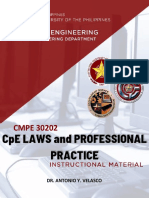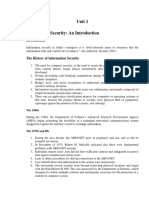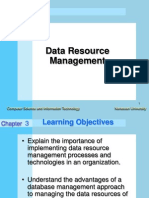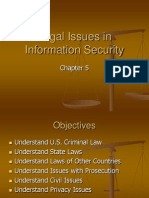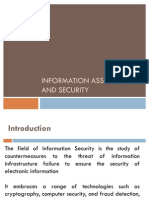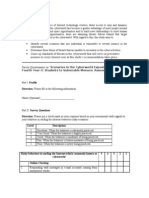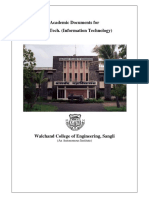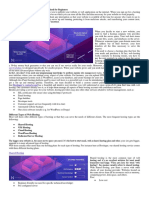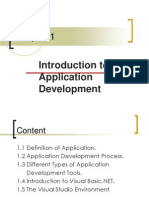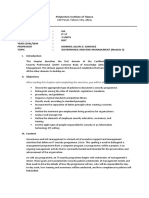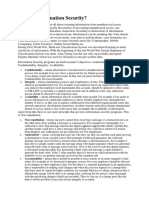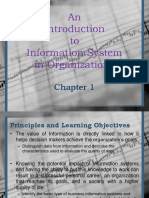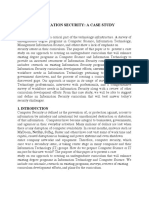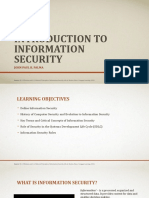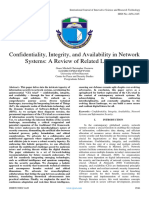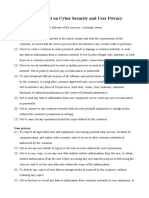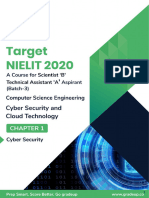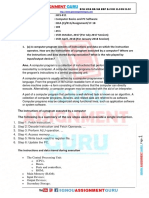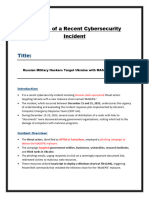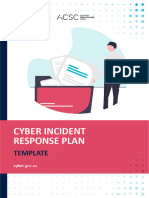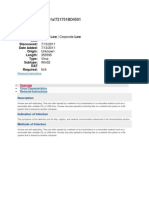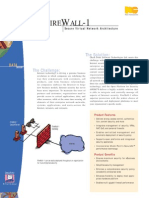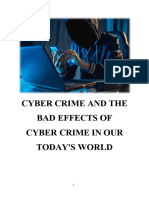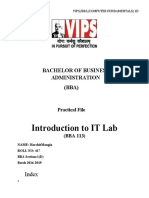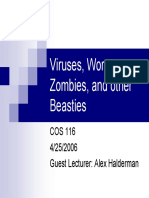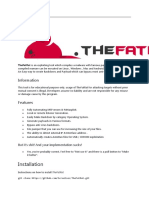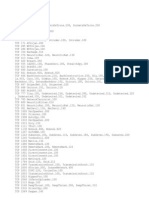100%(1)100% found this document useful (1 vote)
229 viewsEthics, Privacy and Information Security
Ethics, Privacy and Information Security
Uploaded by
Siti Sajarotun NurThe document discusses ethics, privacy, and information security. It covers four categories of ethical issues: privacy, accuracy, property, and accessibility. It then discusses threats to information security such as unintentional acts, natural disasters, technical failures, management failures, and deliberate acts by employees. Finally, it discusses ways to protect information resources through risk analysis, mitigation strategies like risk acceptance, limitation, and transference, and implementing controls.
Copyright:
© All Rights Reserved
Available Formats
Download as PPT, PDF, TXT or read online from Scribd
Ethics, Privacy and Information Security
Ethics, Privacy and Information Security
Uploaded by
Siti Sajarotun Nur100%(1)100% found this document useful (1 vote)
229 views27 pagesThe document discusses ethics, privacy, and information security. It covers four categories of ethical issues: privacy, accuracy, property, and accessibility. It then discusses threats to information security such as unintentional acts, natural disasters, technical failures, management failures, and deliberate acts by employees. Finally, it discusses ways to protect information resources through risk analysis, mitigation strategies like risk acceptance, limitation, and transference, and implementing controls.
Original Description:
3.1 Ethical Issues
3.2 Threats to Information Security
3.3 Protecting Information Resources
Copyright
© © All Rights Reserved
Available Formats
PPT, PDF, TXT or read online from Scribd
Share this document
Did you find this document useful?
Is this content inappropriate?
The document discusses ethics, privacy, and information security. It covers four categories of ethical issues: privacy, accuracy, property, and accessibility. It then discusses threats to information security such as unintentional acts, natural disasters, technical failures, management failures, and deliberate acts by employees. Finally, it discusses ways to protect information resources through risk analysis, mitigation strategies like risk acceptance, limitation, and transference, and implementing controls.
Copyright:
© All Rights Reserved
Available Formats
Download as PPT, PDF, TXT or read online from Scribd
Download as ppt, pdf, or txt
100%(1)100% found this document useful (1 vote)
229 views27 pagesEthics, Privacy and Information Security
Ethics, Privacy and Information Security
Uploaded by
Siti Sajarotun NurThe document discusses ethics, privacy, and information security. It covers four categories of ethical issues: privacy, accuracy, property, and accessibility. It then discusses threats to information security such as unintentional acts, natural disasters, technical failures, management failures, and deliberate acts by employees. Finally, it discusses ways to protect information resources through risk analysis, mitigation strategies like risk acceptance, limitation, and transference, and implementing controls.
Copyright:
© All Rights Reserved
Available Formats
Download as PPT, PDF, TXT or read online from Scribd
Download as ppt, pdf, or txt
You are on page 1of 27
Chapter 3
Ethics, Privacy and
Information Security
Copyright 2007 John
Wiley & Sons, Inc. Chapter 3 1
3.1 Ethical Issues
Ethics. A branch of philosophy that deals
with what is considered to be right and
wrong.
A Code of Ethics is a collection of principles
that are intended to guide decision making by
members of an organization.
Copyright 2007 John
Wiley & Sons, Inc. Chapter 3 2
The Four Categories of Ethical
Issues
Privacy Issues involves collecting, storing and
disseminating information about individuals.
Accuracy Issues involves the authenticity, fidelity
and accuracy of information that is collected and
processed.
Property Issues involves the ownership and value
of information.
Accessibility Issues revolve around who should
have access to information and whether they should
have to pay for this access.
Copyright 2007 John
Wiley & Sons, Inc. Chapter 3 3
Protecting Privacy
Privacy. The right to be left alone and to be
free of unreasonable personal intrusions.
Two rules have been followed fairly closely
in past court decision in many countries:
The right of privacy is not absolutes. Privacy
must be balanced against the needs of society
The public’s right to know is superior to the
individual’s right of privacy.
Copyright 2007 John
Wiley & Sons, Inc. Chapter 3 4
Protecting Privacy (Continued)
Electronic Surveillance. The tracking of
people‘s activities, online or offline, with the
aid of computers.
Personal Information in Databases.
Information about individuals is being kept
in many databases: banks, utilities co., govt.
agencies, …etc.; the most visible locations
are credit-reporting agencies.
Copyright 2007 John
Wiley & Sons, Inc. Chapter 3 5
Protecting Privacy (Continued)
Information on Internet Bulletin Boards
and Newsgroups. Electronic discussions
such as chat rooms and these other sites
appear on the Internet, within corporate
intranets, and on blogs.
A blog (Weblog) is an informal, personal
journal that is frequently updated and
intended for general public reading.
Copyright 2007 John
Wiley & Sons, Inc. Chapter 3 6
Protecting Privacy (Continued)
Privacy Codes and Policies. An
organization’s guidelines with respect to
protecting the privacy of customers, clients,
and employees.
International Aspects of Privacy. Privacy
issues that international organizations and
governments face when information spans
countries and jurisdictions.
Copyright 2007 John
Wiley & Sons, Inc. Chapter 3 7
3.2 Threats to Information Security
A threat to an information resource is any danger to which
a system may be exposed.
The exposure of an information resources is the harm, loss
or damage that can result if a threat compromises that
resource.
A system’s vulnerability is the possibility that the system
will suffer harm by a threat.
Risk is the likelihood that a threat will occur.
Information system controls are the procedures, devices,
or software aimed at preventing a compromise to the system.
Copyright 2007 John
Wiley & Sons, Inc. Chapter 3 8
Categories of Threats to Information
Systems
Unintentional acts, those with no malicious
intent, such as:
Human errors
Social engineering – being tricked by others
Deviations in the quality of service – service is
not delivered as expected
Copyright 2007 John
Wiley & Sons, Inc. Chapter 3 9
Categories of Threats to Information
Systems
Natural disaster include earthquakes, severe
storms, floods, power failures or strong
fluctuations, fires (most common hazard),
explosions, …etc.
Technical failures can occur as the result of
poor manufacturing or defective materials.
Copyright 2007 John
Wiley & Sons, Inc. Chapter 3 10
Categories of Threats to Information
Systems
Management failures involve a lack of
funding for information security efforts.
Deliberate acts by company’s employees:
Trespass
Information extortion
Sabotage or vandalism
Theft
Copyright 2007 John
Wiley & Sons, Inc. Chapter 3 11
Compromises to Intellectual
Property
Intellectual property. Property created by
individuals or corporations which is protected under
trade secret, patent, and copyright laws.
Trade secret. Intellectual work, such as a business
plan, that is a company secret and is not based on
public information.
Patent. Document that grants the holder exclusive
rights on an invention or process for 20 years.
Copyright 2007 John
Wiley & Sons, Inc. Chapter 3 12
Compromises to Intellectual
Property (Continued)
Copyright. Statutory grant that provides
creators of intellectual property with
ownership of the property for life of the
creator plus 70 years.
Piracy. Copying a software program without
making payment to the owner.
Copyright 2007 John
Wiley & Sons, Inc. Chapter 3 13
Software Attacks
Malicious software (malware) designed to
damage, destroy, or deny service to the
targeted systems.
Most common types of software attacks are
viruses, worms, Trojan horses, logic bombs,
back doors, denial-of-service, alien software,
phishing and pharming.
Copyright 2007 John
Wiley & Sons, Inc. Chapter 3 14
Software Attacks (Continued)
Viruses. Segments of computer code that performs
unintended actions ranging from merely annoying
to destructive.
Worms. Destructive programs that replicate
themselves without requiring another program to
provide a safe environment for replication.
Trojan horses. Software progams that hide in other
computer programs and reveal their designed
behavior only when they are activated.
Copyright 2007 John
Wiley & Sons, Inc. Chapter 3 15
Software Attacks (Continued)
Logic bombs. Designed to activate and perform a
destructive action at a certain time.
Back doors or trap doors. Typically a password,
known only to the attacker, that allows access to the
system without having to go through any security.
Denial-of-service. An attacker sends so many
information requests to a target system that the
target cannot handle them successfully and can
crash the entire system.
Copyright 2007 John
Wiley & Sons, Inc. Chapter 3 16
Alien Software
Pestware. Clandestine software that uses up
valuable system resources and can report on your
Web surfing habits and other personal information.
Adware. Designed to help popup advertisements
appear on your screen.
Spyware. Software that gathers user information
through the user’s Internet connection without their
knowledge (i.e. keylogger, password capture).
Copyright 2007 John
Wiley & Sons, Inc. Chapter 3 17
Alien Software (Continued)
Spamware. Designed to use your computer
as a launch pad for spammers.
Spam. Unsolicited e-mail, usually for
purposes of advertising.
Cookies. Small amount of information that
Web sites store on your computer,
temporarily or more-or-less permanently.
Copyright 2007 John
Wiley & Sons, Inc. Chapter 3 18
Alien Software (Continued)
Web bugs. Small, usually invisible, graphic images
that are added to a Web page or e-mail.
Phishing. Uses deception to fraudulently acquire
sensitive personal information such as account
numbers and passwords disguised as an official-
looking e-mail.
Pharming. Fraudulently acquires the Domain
Name for a company’s Web site and when people
type in the Web site url they are redirected to a fake
Web site.
Copyright 2007 John
Wiley & Sons, Inc. Chapter 3 19
3.3 Protecting Information
Resources
Risk. The probability that a threat will impact an
information resource.
Risk management. To identify, control and
minimize the impact of threats.
Risk analysis. To assess the value of each asset
being protected, estimate the probability it might be
compromised, and compare the probable costs of it
being compromised with the cost of protecting it.
Copyright 2007 John
Wiley & Sons, Inc. Chapter 3 20
Protecting Information Resources
(Continued)
Risk mitigation is when the organization
takes concrete actions against risk. It has two
functions:
(1) implement controls to prevent identified
threats from occurring, and
(2) developing a means of recovery should the
threat become a reality.
Copyright 2007 John
Wiley & Sons, Inc. Chapter 3 21
Risk Mitigation Strategies
Risk Acceptance. Accept the potential risk,
continue operating with no controls, and absorb any
damages that occur.
Risk limitation. Limit the risk by implementing
controls that minimize the impact of threat.
Risk transference. Transfer the risk by using other
means to compensate for the loss, such as
purchasing insurance.
Copyright 2007 John
Wiley & Sons, Inc. Chapter 3 22
Controls
Controls evaluation. Identifies security
deficiencies and calculates the costs of
implementing adequate control measures.
Physical controls. Physical protection of computer
facilities and resources.
Access controls. Restriction of unauthorized user
access to computer resources; use biometrics and
passwords controls for user identification.
Copyright 2007 John
Wiley & Sons, Inc. Chapter 3 23
Controls (Continued)
Communications (networks) controls. To protect
the movement of data across networks and include
border security controls, authentication and
authorization.
Firewalls. System that enforces access-control policy
between two networks.
Anti-malware systems. Also called antivirus software,
are software packages that attempt to identify and
eliminate viruses, worms etc
Copyright 2007 John
Wiley & Sons, Inc. Chapter 3 24
Controls (Continued)
Whitelisting and blacklisting. Identify software
that are allowed to run and not allowed to run
Intrusion detection systems. They are designed
to detect all types of malicious network traffic
that cannot be detected by a forewall
Encryption. Process of converting an original
message into a form that cannot be read by
anyone except the intended receiver.
Copyright 2007 John
Wiley & Sons, Inc. Chapter 3 25
Controls (Continued)
All encryption systems use a key.
Symmetric encryption. Sender and the recipient
use the same key.
Public-key encryption. Uses two different keys:
a public key and a private key.
Certificate authority. Asserts that each
computer is identified accurately and provides
the public keys to each computer.
Copyright 2007 John
Wiley & Sons, Inc. Chapter 3 26
Controls (Continued)
Virtual Private Networking. Uses the Internet
to carry information within a company and
among business partners but with increased
security by uses of encryption, authentication
and access control.
Application controls. Controls that protect
specific applications and include: input,
processing and output controls.
Copyright 2007 John
Wiley & Sons, Inc. Chapter 3 27
You might also like
- Cmpe 30202 - Cpe Laws and Professional PracticeDocument119 pagesCmpe 30202 - Cpe Laws and Professional PracticeSilver Wolves83% (6)
- Lesson 3 - Ethics For IT Workers and Its UsersDocument45 pagesLesson 3 - Ethics For IT Workers and Its UsersJhon Edison B. ArzolaNo ratings yet
- Introduction To Information SecurityDocument35 pagesIntroduction To Information SecurityShamika ThomasNo ratings yet
- Cobit Casestudy TIBODocument22 pagesCobit Casestudy TIBOAbhishek KumarNo ratings yet
- EncroChat - Wikipedia PDFDocument6 pagesEncroChat - Wikipedia PDFJosé DíazNo ratings yet
- Ethics in Information TechnologyDocument49 pagesEthics in Information Technologythetechboss100% (1)
- L3 Computer Crime and Computer Crime ActDocument47 pagesL3 Computer Crime and Computer Crime ActLing Siong TeckNo ratings yet
- Information SecurityDocument28 pagesInformation SecurityImtiyaz Ali100% (1)
- Lecture 1 Introduction To The Management of Information SecurityDocument47 pagesLecture 1 Introduction To The Management of Information SecurityJatin ChaudharyNo ratings yet
- Lecture 13 - Security and Ethical ChallengesDocument31 pagesLecture 13 - Security and Ethical ChallengesMika DouglasNo ratings yet
- (Paul Blackmore) Intranets A Guide To Their DesignDocument208 pages(Paul Blackmore) Intranets A Guide To Their DesignRyan Moore100% (1)
- Chapter 04Document60 pagesChapter 04nikoladjonajNo ratings yet
- Chapter 2 Software ProcessDocument19 pagesChapter 2 Software ProcesssanketNo ratings yet
- Lesson 1 Introduction To Information SecurityDocument42 pagesLesson 1 Introduction To Information Securityrazel gicaleNo ratings yet
- 3 - Data Resource ManagementDocument43 pages3 - Data Resource ManagementSaba IlyasNo ratings yet
- Legal Issues in Information Security-Chapter-5Document37 pagesLegal Issues in Information Security-Chapter-5nishit_beraNo ratings yet
- Information Assurance and SecurityDocument15 pagesInformation Assurance and SecurityModupe AbiodunNo ratings yet
- Ethics in Information Technology, Fourth Edition: Computer and Internet CrimeDocument51 pagesEthics in Information Technology, Fourth Edition: Computer and Internet CrimeSaleh ShakibNo ratings yet
- Lecture 1Document78 pagesLecture 1heaven_prince200950% (2)
- Information SecurityDocument72 pagesInformation SecurityManish MadhavNo ratings yet
- Introduction To Information Security Chapter 1Document55 pagesIntroduction To Information Security Chapter 1spannclann100% (1)
- Information Technology Act, 2000Document17 pagesInformation Technology Act, 2000Shraddha TiwariNo ratings yet
- Unit 5 Computer SecurityDocument12 pagesUnit 5 Computer SecurityPauline Torion100% (2)
- Biba ModelDocument33 pagesBiba Modelsg225551100% (1)
- Module 3 - Application Development and Emerging TechnologiesDocument14 pagesModule 3 - Application Development and Emerging TechnologiesArvin BuzonNo ratings yet
- Operating SystemsDocument22 pagesOperating SystemsǷřiţǝƧh ChąuhąnNo ratings yet
- Validated Survey QuestionnairesDocument4 pagesValidated Survey QuestionnairesAnthonyNo ratings yet
- Chapter 1: Introduction To Information SecurityDocument14 pagesChapter 1: Introduction To Information SecurityMicheal GetachewNo ratings yet
- Ethical Privacy and Security IssuesDocument36 pagesEthical Privacy and Security IssuesGlenn AsuncionNo ratings yet
- Management Information System: Introduction ToDocument8 pagesManagement Information System: Introduction ToN-jay ErnietaNo ratings yet
- Computer and Network SecurityDocument22 pagesComputer and Network SecurityAbhishek Upadhyay0% (1)
- Chapter 07 Security TechnologyDocument64 pagesChapter 07 Security TechnologyToboso OyengoNo ratings yet
- Information TechnologyDocument117 pagesInformation TechnologyShreyas SakriNo ratings yet
- Cyber EthicsDocument16 pagesCyber EthicsDeepali RaniNo ratings yet
- IS Lab ManualDocument34 pagesIS Lab ManualrahulNo ratings yet
- What Is Web HostingDocument6 pagesWhat Is Web Hostingrchl.nwtnNo ratings yet
- 1 Information Security Audit and Analysis Introduction 02-08-2021 (02 Aug 2021) Material - I - 02 Aug 2021 - 01 - IntroductionDocument37 pages1 Information Security Audit and Analysis Introduction 02-08-2021 (02 Aug 2021) Material - I - 02 Aug 2021 - 01 - IntroductionPIYUSH RAJ GUPTANo ratings yet
- BTECDocument11 pagesBTECRini SandeepNo ratings yet
- Chap 1 Introduction To Computer SecurityDocument19 pagesChap 1 Introduction To Computer SecurityZorroXNo ratings yet
- Lesson 1 - Introduction To System IntegrationDocument27 pagesLesson 1 - Introduction To System Integrationmark daniel beato100% (1)
- Group Decision Support System - 1Document26 pagesGroup Decision Support System - 1Deepika Aggarwal75% (4)
- Chapter 1 - Introduction To Application DevelopmentDocument41 pagesChapter 1 - Introduction To Application DevelopmentVinoden SingaravelooNo ratings yet
- Security and Ethical ChallengesDocument9 pagesSecurity and Ethical ChallengesPranToNo ratings yet
- Computer Programming LanguagesDocument5 pagesComputer Programming LanguagesMeïssa BABOUNo ratings yet
- Information Assurance and Security (GOVERNANCE and RISK MANAGEMENT - Module5)Document5 pagesInformation Assurance and Security (GOVERNANCE and RISK MANAGEMENT - Module5)Marneil Allen SanchezNo ratings yet
- Lecture - 1 - What Is Information SecurityDocument8 pagesLecture - 1 - What Is Information SecurityvaishaliguptaNo ratings yet
- Concept of ICTDocument8 pagesConcept of ICTanon_786496217100% (1)
- Module 1 AssignmentDocument4 pagesModule 1 Assignmentapi-360051483No ratings yet
- Module 2 - Application Development and Emerging TechnologiesDocument18 pagesModule 2 - Application Development and Emerging TechnologiesArvin BuzonNo ratings yet
- Fundamentals of Information SystemDocument63 pagesFundamentals of Information SystemBeth BauzonNo ratings yet
- 05 CDAD2103 Topic 1Document16 pages05 CDAD2103 Topic 1Sean ChinNo ratings yet
- 06 Computer Ethics and Cyber Laws CGDocument52 pages06 Computer Ethics and Cyber Laws CGAnurag Tandon100% (1)
- Week 10 IntegrationDeploymentDocument29 pagesWeek 10 IntegrationDeploymentDianne Austria GuarinoNo ratings yet
- 07 - Basic CryptographyDocument46 pages07 - Basic CryptographyHưng VdnNo ratings yet
- Lecture 01 - Organisations and Information SystemsDocument30 pagesLecture 01 - Organisations and Information SystemsusmanziaibianNo ratings yet
- Information Security A Case Study3Document8 pagesInformation Security A Case Study3ragunathrevNo ratings yet
- Nformation Ecurity Olicy: HapterDocument51 pagesNformation Ecurity Olicy: HapterBin FlanNo ratings yet
- Introduction To Information SecurityDocument25 pagesIntroduction To Information Securitybheng avilaNo ratings yet
- Confidentiality, Integrity, and Availability in Network Systems: A Review of Related LiteratureDocument10 pagesConfidentiality, Integrity, and Availability in Network Systems: A Review of Related LiteratureInternational Journal of Innovative Science and Research TechnologyNo ratings yet
- Objective Syllabus Notes Quiz WEB ReferencesDocument23 pagesObjective Syllabus Notes Quiz WEB Referencesyusairri100% (2)
- Managing Information Resources and Security: Information Technology For Management 6 EditionDocument44 pagesManaging Information Resources and Security: Information Technology For Management 6 EditionVinay AroraNo ratings yet
- Commitment On Cyber Security and User Privacy TemplateDocument2 pagesCommitment On Cyber Security and User Privacy Templatenureddin eljamlNo ratings yet
- Cyber Security & Cloud ComputingDocument32 pagesCyber Security & Cloud ComputingLAXMAN MEENANo ratings yet
- BCS 011 IgnouAssignmentGuruDocument31 pagesBCS 011 IgnouAssignmentGuruAmanKumarNo ratings yet
- Russian Military Hackers Target Ukraine With MASEPIE MalwareDocument6 pagesRussian Military Hackers Target Ukraine With MASEPIE MalwareASAD ULLAHNo ratings yet
- Cyber Incident Response Plan TeDocument43 pagesCyber Incident Response Plan Telava.sky10No ratings yet
- Master FileDocument65 pagesMaster FileCA Pavan KommuriNo ratings yet
- Virus 2Document5 pagesVirus 2Pulsar RajasekarNo ratings yet
- Firewall 1 DatasheetDocument4 pagesFirewall 1 Datasheetsunil_ppipalNo ratings yet
- CompTIA Security+ SY0-301 Practice TestDocument28 pagesCompTIA Security+ SY0-301 Practice TestMichael RoseNo ratings yet
- (IJCST-V6I3P36) :khadarbasha - Dada, T Sai Prasad ReddyDocument12 pages(IJCST-V6I3P36) :khadarbasha - Dada, T Sai Prasad ReddyEighthSenseGroupNo ratings yet
- Cyber Crime and The Bad Effects of Cyber Crime in Our Today 2655 (1027)Document42 pagesCyber Crime and The Bad Effects of Cyber Crime in Our Today 2655 (1027)Jhon Dave S. Sta. MariaNo ratings yet
- Injection 7 Information On Ransomware Attack and MeasuresDocument8 pagesInjection 7 Information On Ransomware Attack and MeasuresXayDung 56CD5No ratings yet
- S N eSET KUYHAADocument2 pagesS N eSET KUYHAAHeppy Dwi YutantoNo ratings yet
- Forrester TechTideDocument36 pagesForrester TechTidetomerNo ratings yet
- Introduction To IT Lab: Bachelor of Business Administration (BBA)Document22 pagesIntroduction To IT Lab: Bachelor of Business Administration (BBA)ram avtar BansalNo ratings yet
- Assignment#3 Atif AliDocument8 pagesAssignment#3 Atif AliAtif AliNo ratings yet
- The MSPs Response Guide To A Ransomware AttackDocument4 pagesThe MSPs Response Guide To A Ransomware Attackderic soonNo ratings yet
- Chapter 3 Quiz - Introduction To Cybersecurity 0420Document10 pagesChapter 3 Quiz - Introduction To Cybersecurity 0420Egy RenataNo ratings yet
- Validation, Deallocation and NamingDocument8 pagesValidation, Deallocation and Naminggautampujan208No ratings yet
- Viruses and WormDocument36 pagesViruses and WormabdeelNo ratings yet
- ContiDocument7 pagesContiHuy nguyen vietNo ratings yet
- Deliberate Act of Sabotage or VandalismDocument6 pagesDeliberate Act of Sabotage or VandalismKhethollo MahlokoNo ratings yet
- The Fat RatDocument5 pagesThe Fat RatKwame Kakari0% (1)
- Trojan PortsDocument8 pagesTrojan Ports143hellowNo ratings yet
- EmpTech Lesson 1Document7 pagesEmpTech Lesson 1Princessmae BermejoNo ratings yet
- New Question Premium 45 - ExplainDocument47 pagesNew Question Premium 45 - Explainanhtu9_910280373No ratings yet
- Application of Machine Learning in CybersecurityDocument19 pagesApplication of Machine Learning in Cybersecuritypratap100% (1)
- Top 110 Cyber Security Interview Questions & Answers: 1) What Is Cybersecurity?Document21 pagesTop 110 Cyber Security Interview Questions & Answers: 1) What Is Cybersecurity?শ্রী লিমন চন্দ্র মোহন্ত100% (1)
